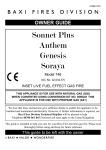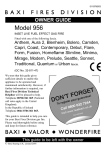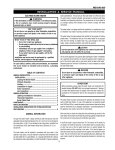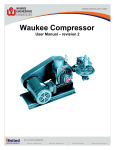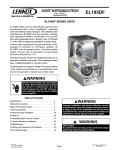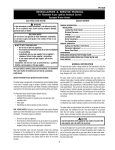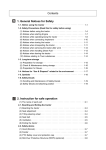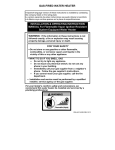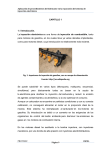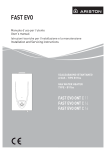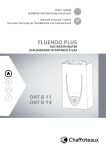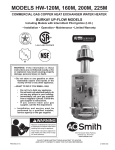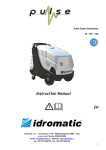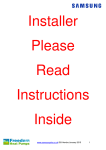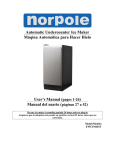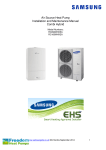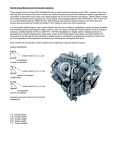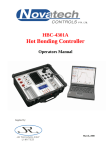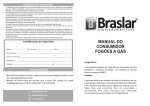Download Manuals - Lochinvar
Transcript
CGR-I&S INSTALLATION & SERVICE MANUAL GAS-FIRED COMMERCIAL WATER HEATER The warranty for this water heater is in effect only when the water heater is installed, adjusted, and operated in accordance with these Installation and Operating Instructions. The warranty does not cover damage or injury caused by the use of any energy-saving devices (other than those authorized by the manufacturer) in conjunction with this water heater. The use of unauthorized energy-saving devices may decrease the life of the water heater and endanger life and/or property. The manufacturer will not be liable for any damage, injury, or loss of life resulting from alteration and/or failure to comply with these instructions. WARNING If the information in these instructions is not followed exactly, a fire or explosion may result causing property damage, personal injury or death. FOR YOUR SAFETY Do not store or use gasoline or other flammable, combustible, or corrosive vapors and liquids in the vicinity of this or any other appliance. This water heater has been equipped for use with one type of gas only. Compare the information provided on the rating plate, affixed to the front of the water heater, making sure that the gas stated on the rating plate is same as the gas to be used. WHAT TO DO IF YOU SMELL GAS • Do not try to light any appliance. • Do not touch any electrical switch; do not use any telephone in your building. • Immediately call your gas supplier from a neighbor’s telephone. Follow the gas supplier’s instructions. • If you cannot reach your gas supplier, call the fire department. Installation and service must be performed by a qualified installer, service agency or the gas supplier. CAUTION Do not attempt to use this water heater with any gas other than the type listed on the rating plate. Do not attempt to convert this water heater for use with a gas other than the type for which it is equipped. Failure to use the proper gas can create an unsafe condition resulting in property damage, bodily injury, or death. Consult your local gas supplier or Gas Company if there are any questions. This water heater must be installed in accordance with local codes. In the absence of local codes. It must be installed in compliance with the National Fuel Gas Code (ANSI Z223.1 and Lastest Edition), or in Canada CAN/CGA B149.1 Natural Gas Installation Code (Latest Edition) or CAN/CGA B149.2 Propane Installation Code (Latest Edition). For safety, convenience, and best performance, we recommend this water heater be installed and serviced by a plumbing professional. TABLE OF CONTENTS GENERAL INFORMATION............................................................... 1 INSTALLATION ......................................................................... 2 Locating The Water Heater .............................................. 2 Minimum Clearances ........................................................ 2 Venting ............................................................................ 5 Combustion Air Supply .................................................... 5 Water Connections .......................................................... 6 Gas Connections .............................................................. 7 GENERAL OPERATION ................................................................... 8 Wiring Diagrams Standing Pilot Wiring Diagram....................................... 8 Spark Ignition Wiring Diagram....................................... 9 Lighting and Shutdown Instructions .................................... 10 Standing Pilot Models ................................................... 10 Spark Ignition Models ................................................... 10 Thermostat Adjustment ................................................. 11 Burner Flame Check ........................................................ 11 MAINTENANCE ............................................................................ 12 OPERATING & TROUBLESHOOTING GUIDE .................................. 13 TEMPERATURE CONTROL CHECKOUT .......................................... 16 INSTALLATION INSTRUCTIONS FOR POTABLE WATER AND SPACE HEATING .......................................................................... 17 FAN INDUCED COMBUSTION....................................................... 18 For installations in high altitude regions, this water heater must be ordered from the supplier to the manufacturer’s specifications for that particular altitude. Contact the company listed on the rating plate when ordering high altitude constructed water heaters. This water heater has been designed and certified for the purpose of heating potable water. This installation and use of this water heater for any purpose other than the heating of potable water may cause damage to the water heater, create a hazardous condition, and nullify the warranty. CAUTION Incorrect operation of this appliance may create a hazard to life and property and will nullify the warranty. DANGER Do not store or use gasoline or other flammable, combustible, or corrosive vapors and liquids in the vicinity of this or any other appliance. GENERAL INFORMATION IMPORTANT Before proceeding, please inspect the water heater and components for possible damage. DO NOT install any damaged components. If damage is evident then please contact the supplier where the water heater was purchased or the manufacturer listed on the rating plate for replacement parts. This gas-fired water heater is design certified by the American Gas Association Laboratories under the applicable American National Standard, Z21.10.1 or Z21.10.3 (as indicated on the rating plate), available from the American Gas Association, 1515 Wilson Blvd., Arlington, VA 22209. 1 CGR-I&S INSTALLATION WHAT TO DO IF YOU SMELL GAS • Do not try to light any appliance. • Do not touch any electrical switch; do not use any telephone in your building. • Immediately call your gas supplier from a neighbor’s telephone. Follow the gas supplier’s instructions. • If you cannot reach your gas supplier, call the fire department. DO NOT OPERATE APPLIANCE UNTIL LEAKAGE IS CORRECTED! Locating The Water Heater WARNING Water heaters are heat producing appliances. To avoid damage or injury there shall be no materials stored against the water heater or vent-air intake system and proper care shall be taken to avoid unnecessary contact (especially by children) with the water heater and vent-air intake components. UNDER NO CIRCUMSTANCES SHALL FLAMMABLE MATERIALS, SUCH AS GASOLINE OR PAINT THINNER BE USED OR STORED IN THE VICINITY OF THIS WATER HEATER, VENT-AIR INTAKE SYSTEM OR IN ANY LOCATION FROM WHICH FUMES COULD REACH THE WATER HEATER OR VENT-AIR INTAKE SYSTEM. WARNING DO NOT ATTEMPT TO LIGHT ANY GAS APPLIANCE IF YOU ARE NOT CERTAIN OF THE FOLLOWING: • Liquefied petroleum gases/propane gas and natural gas have an odorant added by the gas supplier that aids in detection of the gas. • Most people recognize this odor as a “sulfur” or “rotten egg” smell. • Other conditions, such as “odorant fade” can cause the odorant to diminish in intensity, or “fade”, and not be as readily detectable. • If you have a diminished sense of smell, or are in any way unsure of the presence of gas, immediately contact your gas supplier from a neighbor’s telephone. • Gas detectors are available. Contact your gas supplier or plumbing professional for more information. This water heater must NOT be installed in any location where gasoline or flammable vapors are likely to be present, unless the installation is such to eliminate the probable ignition of gasoline or flammable vapors. The location of this water heater is of the utmost importance. Before installing this water heater, you should read the Installation section of these instructions. After reading these Installation and Operating Instructions, select a location for the water heater where the floor is level and is easily accessible to water lines, gas supply (type identified on the rating plate), an adequate open drain, and a chimney or exhaust gas vent. DO NOT locate the water heater where water lines could be subjected to freezing temperatures. Make sure the cold water pipes are not located directly above the gas control box or any other electrical control so that condensate during humid weather does not drip on the controls. Proper venting practices must be considered when selecting a location for this water heater. For exact venting specifications, please consult the Venting section, located on page 5 of these Installation and Operating Instructions. This water heater must be located in an area where leakage of the tank, water line connections, or the combination temperature and pressure relief valve will not result in damage to the area adjacent to the water heater or to lower floors of the structure. When such locations cannot be avoided, a suitable drain pan must be installed under the water heater. The drain pan must be no greater than 1 ½ inches (3.8 cm) deep and have a minimum length and width of at least four (4) inches (10.2 cm) measured from the jacket of the water heater. The drain pan, as described above, can be purchased from your plumbing professional. The drain pan must be piped to an adequate drain. The piping must be at least ¾ inch (1.9 cm) in diameter and pitched for proper drainage. Adequate clearances shall be provided for easy access to controls by service personnel to enable proper cleaning, servicing, and operation of the water heater. Under no circumstances is the front of the water heater to be placed in a position where the burner tray assembly can not slide out for removal when servicing. Water heater corrosion and component failure can be caused by the heating and breakdown of airborne chemical vapors. Examples of some typical compounds that are potentially corrosive are: spray can propellants, cleaning solvents, refrigerator and air conditioning refrigerants, swimming pool chemicals, calcium and sodium chloride, waxes and process chemicals. These materials are corrosive at very low concentration levels with little or no odor to reveal their presence. NOTE: DAMAGE TO THE WATER HEATER CAUSED BY EXPOSURE TO CORROSIVE VAPORS IS NOT COVERED BY THE WARRANTY. DO NOT OPERATE THE WATER HEATER IF EXPOSURE HAS OR WILL OCCUR. DO NOT STORE ANY POTENTIALLY CORROSIVE COMPOUNDS IN THE VICINITY OF THE WATER HEATER. It is recommended that a minimum clearance of four (4) inches (10.2 cm) be provided on the side of the water heater for servicing and maintenance of the combination temperature and pressure relief valve. MINIMUM CLEARANCES WARNING Failure to adhere to these installation and operating instructions may create a hazard to life and property and will nullify the warranty. This installation shall allow access to the front of the water heater and adequate clearance shall be provided for servicing and operating this water heater. The water heater may be installed on either a combustible or non-combustible floor. If the water heater is to be installed directly on carpeting, it shall be installed on top of a metal or wood panel (or equivalent) extending beyond the full width and depth of the appliance by at least there (3) inches (7.6 cm) in any direction or, if the appliance is to be installed in alcove or closet, the entire floor shall be covered by the panel. The minimum clearances to combustibles for this water heater are given in the tables on pages 3 through 4. A minimum of 24 inches front clearance shall be provided for inspection and servicing. WARNING Liquefied petroleum gases/propane gas are heavier than air and will remain at floor level if there is a leak. Basements, crawl spaces, closets and areas below ground level will serve as pockets for accumulation of leaking gas. Before lighting, smell all around the appliance area for gas. Be sure to smell next to the floor. 2 CGR-I&S CAUTION The National Fuel Gas Code (ANSI Z233.1- or latest edition) and CAN/CGA (B149.1- or latest edition), expressly prohibits the following: a) Installation of a water heater in a bathroom, bedroom, or any occupied room normally kept closed. b) Installation of a water heater in a garage, unless the unit is installed so that the burner and ignition devices are at least eighteen (18) inches (45.8 cm) above floor level and protected to avoid damage by a moving vehicle. Figure 1 Figure 2 Flue Damper Models (Figure 1) Model Description Capacity Input (BTU/hr) (GAL) Nat. LP 100 199,999 199,999 80 399,999 375,000 80 505,000 475,000 A (in) B (in) C (in) 74.88 71.06 69.03 65.19 60.03 60.03 56.38 51.56 51.56 D (in) E (in) F (in) Sides and Rear (in) 4.56 10.19 10.19 23 N/A N/A 6 8 10 2 6 6 Clearances * Flue or Ceiling Vent (in) (in) 6 6 6 Model Description Capacity (LITERS) 378.5 302.8 302.8 Input (kW/hr) Nat. 58.7 117.3 148.0 LP 58.7 109.9 139.3 20 20 20 Clearances * A (cm) B (cm) C (cm) D (cm) E (cm) F (cm) Sides and Flue or Rear (cm) Vent (cm) 1.90 1.81 1.75 1.66 1.53 1.53 1.43 1.31 1.31 11.6 25.9 25.9 58.4 N/A N/A 15.2 10.2 25.4 5.1 15.3 15.3 Ceiling (cm) 15.3 15.3 15.3 50.8 50.8 50.8 Flue Damper Models (Figure 2) Model Description Capacity Input (GAL) (BTU/hr) 65 75 370,000 300,000 Model Description Capacity Input (kW/hr) (Liters) 246.1 283.9 108.5 88.0 A (in) B (in) C (in) D (in) 71.38 72.00 64.38 64.38 54.13 54.13 8 7 A (cm) B (cm) C (cm) D (cm) Sides and Rear (cm) Flue or Vent (cm) 1.82 1.83 1.64 1.64 1.38 1.38 20.4 17.8 15.3 15.3 15.3 17.8 3 Sides and Rear (in) Clearances * Flue or Ceiling Vent (in) (in) 6 6 6 7 20 20 Clearances * Ceiling (cm) 50.8 50.8 CGR-I&S Installation (Minimum Clearances) continued- Figure 3 Figure 4 Flue Damper Models (Figure 3) Model Description Capacity Input (GAL) (BTU/hr) 38 155,000 A (in) 51.00 B (in) 43.00 C (in) 34.75 D (in) 33.75 E (in) 6 Sides and Rear (in) 2 Clearances * Flue or Ceiling Vent (in) (in) 6 20 Model Description Capacity Input (Liters) (kW/hr) 143.9 45.5 A (cm) 1.30 B (cm) 1.10 C (cm) 0.88 D (cm) 0.88 E (cm) 15.3 Sides and Rear (cm) 5.1 Clearances * Flue or Ceiling Vent (cm) (cm) 15.3 50.8 Clearances * Flue or Ceiling Vent (in) (in) 6 20 6 20 6 20 6 20 Flue Damper Models (Figure 4) Model Capacity (GAL) 80 80 98 98 100 Description Input (BTU/hr) 180,000 199,999 199,999 250,000 (235,000 LP) 199,999 Model Description Capacity Input (Liters) (kW/hr) 302.8 52.8 302.8 58.7 371.0 52.8 371.0 73.3 (68.9 LP) 378.5 52.8 A (in) 71.88 71.88 82.88 82.88 B (in) 64.38 64.38 75.38 75.38 C (in) 64.38 64.38 75.38 75.38 D (in) 56.00 56.00 67.00 67.00 E (in) 55.13 55.13 66.13 66.13 Sides and Rear (in) 2 2 2 2 75.50 69.88 61.88 60.38 56.88 2 A (m) 1.83 1.83 2.11 2.11 B (m) 1.69 1.69 1.97 1.97 C (m) 1.64 1.64 1.92 1.92 D (m) 1.43 1.43 1.71 1.71 E (m) 1.40 1.40 1.68 1.68 Sides and Rear (cm) 5.1 5.1 5.1 5.1 1.92 1.78 1.58 1.54 1.45 5.1 4 6 20 Clearances * Flue or Ceiling Vent (cm) (cm) 15.3 50.8 15.3 50.8 15.3 50.8 15.3 50.8 15.3 5 0.8 CGR-I&S The following notes apply the tables accompanying Figures 1-4. CAUTION Modification to the flue damper or the draft diverter may result in personal injury, property damage or death. The flue damper and draft diverter are to be placed in position and operate exactly as stated in these instructions 1. All models with flue dampers and/or above 400,000 Btu/hr input employ a “spark” (IID) ignition system and requires 120 volt AC electric supply. without modification. 2. * -Denotes minimum clearances to combustible material. Some models may have different clearances. Check the label on the front of the water heater to verify proper installation clearances. Figure 5 DRAFT DIVERTER VENTING DAMPER COVER DAMPER VANE WARNING COLLECTOR OUTLET The vent system must be installed properly. Failure to properly install the vent system could result in property damage, personal injury, or death. JACKET TOP CONNECTOR PLUG This water heater must be connected to a masonry chimney or venting system approved by local codes or ordinances. This vent connector used to attach the draft diverter outlet to the chimney or approved vent must be of the same diameter as the draft diverter outlet or larger. For proper venting in certain installations, a large vent connector may be needed. Consult venting tables in ANSI standard (Z223.1-latest edition), National Fuel Gas Code and CAN/CGA (B149.1 or B149.2 – latest editions), or local code officials for proper application for your area. WIRE HARNESS COMBUSTION AIR SUPPL Y WARNING Liquefied petroleum gases/propane gas are heavier than air and will remain at floor level if there is a leak. Basements, crawl spaces, closets and areas below ground level will serve as pockets for accumulation of leaking gas. Before lighting, smell all around the appliance area for gas. Be sure to smell next to the floor. WHAT TO DO IF YOU SMELL GAS • Do not try to light any appliance. • Do not touch any electrical switch; do not use any telephone in your building. • Immediately call your gas supplier from a neighbor’s telephone. Follow the gas supplier’s instructions. • If you cannot reach your gas supplier, call the fire department. DO NOT OPERATE APPLIANCE UNTIL LEAKAGE IS CORRECTED! Flue Damper Refer to Figure 5 and follow these instructions: CAUTION Do not turn on electrical power to water heater until flue damper is installed and water heater is filled with water. 1. Remove the damper from the accompanying box shipped within the crate. 2. Locate the collector outlet on top of the water heater. Place the damper over the collector outlet and rotate as necessary to a position in which the damper wiring plug can be fully engaged with the connector on the side of the water heater. 3. If applicable, remove clip which holds damper vane closed. This type of vent damper will then open by itself. 4. Secure the flue damper to the jacket top with sheet metal screws. Note: Some dampers require an additional bracket to assure level installation. 5. Connect the damper wiring plug to the connector on the side of the water heater. Note: The plug and connector can only be engaged one way (polarized). 6. The Lighting and Operating instructions are outlined beginning on page 9. The damper must be in the open position when the water heater main burner is operating (the arrow on the damper plate is in the “up” position when open. Be certain the arrow is in a visible position when installed). IMPORTANT The flow of combustion and ventilating air must not be obstructed. Provide adequate air for combustion and ventilation. An insufficient supply of air will cause recirculation of combustion products resulting in air contamination that may be hazardous to life. Such a condition often will result in a yellow, luminous burner flames, causing carboning or sooting of the burners and flue tubes with possible damage to the heater. Confined Spaces If the water hater is installed in a confined space (volume is less that 50 ft 3/ 1000 Btu (15 m 3/0.29kW) per hour of the total input rating of all gas appliances in that space), air must be supplied through two permanent openings. One opening shall be within 12 inches (30.5 cm) from the top of the enclosure and one within 12 inches (30.5 cm) of the bottom. The openings must be protected by metal louvers or ¼” (6.4 mm) min. mesh meal screen. The size of the openings are as follows. Draft Diverter This water heater has been shipped with a draft diverter for which it was designed. Remove the bag containing the legs and instructions from the draft diverter. Attach the legs to the draft diverter and attach the draft diverter to the water heater per the instructions in the bag. 5 CGR-I&S 1. If the openings communicate directly with an additional room(s) of sufficient volume, each opening shall have a minimum free area opening of 1 in 2/ 1000 Btu (2.54 cm 2/0.29kW) per hour of the total input rating of all gas appliances in the confirmed space, but not less that 100 in 2(254 cm 2). close the faucet. The COLD water inlet and HOT water outlet are identified on the top and front of the water heater. Make sure the dip tube is in place before making the cold water connection. Make the proper plumbing connections between the water heater and the plumbing system to the house. Install a shut-off valve in the cold water supply line. 2. If the openings communicate with the outdoors through horizontal ducts, each opening shall have a minimum free area of 1 in 2/2000 Btu (2.54 cm 2/0.59kW) per hour of the total rating of all gas appliances in the enclosure. CAUTION If sweat fittings are to be used, DO NOT apply heat to the nipples on top of the water heater. Sweat the tubing to the adapter before fitting the adapter to the water connections. It is imperative that heat is not applied to the nipples containing a plastic liner. 3. If the openings communicate directly with the outdoors or through vertical ducts with outdoors, each opening shall have a minimum free area of 1 in 2/4000 Btu (2.54 cm 2/1.18kW) per hour of the total rating of all gas appliances in the enclosure. WARNING FAILURE TO INSTALL AND MAINTAIN A NEW, LISTED ¾” X ¾” TEMPERATURE AND PRESSURE RELIEF VALVE WILL RELEASE THE MANUFACTURER FROM ANY CLAIM WHICH MIGHT RESULT FROM EXCESSIVE TEMPERATURE AND PRESSURES. CAUTION The draft diverter relief opening of the water heater and combustion air inlet must be in the same atmospheric pressure zone. Large exhaust fans in kitchens and other locations can lower the air pressure inside an enclosure and interfere with the proper operation and venting of the water heater. In these cases, the water heater should be installed in a separate room with the combustion and ventilation air supplied directly from outdoors as previously described. If this water heater is installed in a closed water supply system, such as the one having a back-flow preventer in the cold water supply, provisions shall be made to control thermal expansion. DO NOT operate this water heater in a closed system without provisions for controlling thermal expansion. Warranties do not cover damages from thermal expansions such as pressure bulges and/or deformities. Your water supplier or local plumbing inspector should be contacted on how to control this situation. All Air From Inside the Building: The confined space shall be provided with two permanent openings communicating directly with an additional room(s) of sufficient volume so that the combined volume of all spaces meets the criteria for an unconfined space. The total input of all gas utilization equipment installed in the combined space shall be considered in making this determination. Each opening shall have a minimum free area of 1 in 2/1000 Btu (2.54 cm 2/ 0.29kW) per hour of the total input rating of all gas utilization equipment in the confined space, but not less that 100 square inches (254 cm2). One opening shall be within 12 inches (30.5 cm) of the top and one within 12 inches (30.5 cm) of the bottom of the enclosure. After installation of the water lines, open the main water supply valve and fill the water heater. While the water heater is filling, open several hot water faucets to allow air to escape from the water system. When a steady stream of water flows through the faucets, close them and check all water connections for possible leaks. NEVER OPERATE THE WATER HEATER WITHOUT FIRST BEING CERTAIN IT IS FILLED WITH WATER. CAUTION Keep clear of combination temperature and pressure relief valve discharge line outlet. The discharge may be hot enough to cause scald injury. The water is under pressure and may splash. Unconfined Spaces In unconfined spaces in buildings, infiltration may be adequate to provide air for combustion, ventilation and dilution of flue gases. However, in buildings of tight construction (for example, weather stripping, heavily insulated, caulked, vapor barrier, etc.), additional air may need to be provided using the methods described above under CONFINED SPEACES: All Air From Outdoors or SPECIALLY ENGINEEERED INSTALLATIONS. This water heater can deliver scalding temperature water at any faucet in the system. Be careful whenever using hot water to avoid scalding injury. Certain appliances such as dishwashers and automatic clothes washer may require increased temperature water. By setting the thermostat on this water heater to obtain the increased temperature water required by theses appliances, you may create the potential for scald injury. To protect against injury, you should install an anti-scaled tempering valve in the water system. This valve will reduce point of discharge temperature by mixing cold and hot water in branch supply lines. Such valves are available from the local plumbing supplier. Please consult with a plumbing professional. For information regarding space heating water connections and plumbing arrangements, refer to page 16. Specially Engineered Installations The requirements noted under CONFINED SPACES above shall not necessarily govern when special engineering, approved by the authority having jurisdiction, provides an adequate supply of air for combustion, ventilation, and dilution of flue gases. WATER CONNECTIONS Note: BEFORE PROCEEDING WITH THE INSTALLATION, CLOSE THE MAIN WATER SUPPLY VALVE. After shutting off the main water supply, open a faucet to relieve the water line pressure to prevent any water from leaking out of the pipes while making the water connections to the water heater. After the pressure has been relieved, 6 CGR-I&S WARNING For protection against excessive temperatures and pressure, install temperature and pressure protective equipment required by local codes, but not less than a combination temperature and pressure relief valve certified by a nationally recognized testing laboratory that maintains periodic inspection of production of listed equipment or materials as meeting the requirements of the Standard for Relief Valves and Automatic Gas Shutoff Devices for Hot Water Supply Systems, ANSI Z21.22 or the Standard CAN1-4.4. Temperature and Pressure and the Standard CAN1-4.4, Temperature, Pressure, Temperature and Pressure Relief Valves and Vacuum Relief Valves. The combination temperature and pressure relief valve shall be marked with a maximum set pressure not to exceed the maximum working pressure of the water heater. The combination temperature and pressure relief valve shall also have an hourly rated temperature steam BTU discharge capacity not less than the hourly rating of the water heater. Install the combination temperature and pressure relief valve into the opening provided and marked for this purpose on the water heater. NOTE: Some models may already be equipped or supplied with a combination temperature and pressure relief valve. Verify that the combination temperature and pressure relief valve complies with local codes. If the combination temperature and pressure relief valve does not comply with local codes, replace it with one that does. Follow the installation instructions above on this page. GAS CONNECTIONS The gas supply lines must meet all requirements of the National Fuel Gas Code (ANSI Z223.1-Latest Edition), or in Canada CAN/CCGS B149.1 Natural Gas Installation Code (Latest Edition), or CAN/CGA B149.2 propane installation code (Lastest edition). The minimum permissible gas supply pressure for the purpose of input adjustment is one (1.0) inch (0.25kPa) water column above the operating manifold pressure. See the rating plate and gas valve for the manifold pressure and gas type. The maximum permissible gas supply pressure is fourteen (14.0) inches (3.5kPa) water column for natural gas and liquefied petroleum gases/propane gas. Install a discharge line so that water discharged from the combination temperature and pressure relief valve will exit within six (6) inches (15.2 cm) above, or any distance below the structural floor and cannot contact any live electrical part. The discharge line is to be installed to allow for complete drainage of both the combination temperature and pressure relief valve and the discharge line. The discharge opening must not be subjected to blockage or freezing. DO NOT thread, plug or cap the discharge line. It is recommended that a minimum clearance of four (4) inches (10.2 cm) be provided on the side of the water heater for servicing and maintenance of the combination temperature and pressure relief valve. 1. Connect this water heater only to the type of gas (Natural or Propane gas) as shown on the rating plate. Use clean black iron pipe or equivalent material approved by local codes and ordinances. (Dirt and scale from the pipe can enter the gas valve and cause it to malfunction). The inlet gas line must have a minimum length of three (3) inches (7.6 cm) drip leg (sediment trap) installed as close to the water heater’s gas valve as possible. A ground joint union must be installed in the gas supply line, as close to the water heater as possible, feeding the water heater to permit servicing of the water heater. Compounds used on the threaded joints of the gas piping must be resistant to the action of liquefied petroleum gasses/propane gas. DO NOT apply pipe dope to the gas valve inlet and make certain that no pipe dope has become lodged in the inlet screen of the gas valve. Extreme care shall be taken to ensure no pipe dope enters the gas valve and to avoid excessive torque when tightening the gas supply line to the gas valve. Excessive torque may result in cracking of the gas valve housing. The suggested maximum torque is 31.5 ft. lbs. (4.4 kg-m). The manufacturer of this water heater will not be liable for any damage or injury caused as a result of a cracked gas inlet as a result of excessive torque. 2. This water heater and its gas connection must be leak tested before placing the water heater in operation. Check for gas leaks with a soap and water solution and a brush or a commercial leak detector fluid. NEVER USE A MATCH OR OPEN FLAME FOR TESTING! Do not place a valve between the combination temperature and pressure relief valve and the tank. WARNING Hydrogen gas can be produced in an operating water heater that has not had water drawn from the tank for a long period of time (generally two weeks or more). Hydrogen gas is extremely flammable. To prevent the possibility of injury under these conditions, we recommend the hot water faucet to be open for several minutes at the kitchen sink before you use any electrical appliance which is connected to the hot water system. If hydrogen is present, there will be an unsual sound such as air escaping through the pipes as hot water begins to flow. Do not smoke or have open flame near the faucet at the time it is open. 7 CGR-I&S TO FILL THE WATER HEATER 1. Close the water heater drain valve by turning the knob clockwise. If alternative water connections are provided but not used, make certain they are plugged (i.e. rear connections). 2. Open the cold water supply shutoff valve. 3. Open several hot water faucets to allow air to escape from the system. 4. When a steady stream of water flows from the faucets, the water heater is filled. Close the faucets and check for water leaks at the water heater drain valve, combination temperature and pressure relief valve and the hot and cold water connections. CAUTION The water heater and individual shutoff valve must be disconnected from the gas supply piping system during any pressure testing of the system at test pressures in excess of ½ psi (3.5 kPa). The water heater must be isolated from the gas supply piping system by closing its manual shutoff valve during any pressure testing of the gas supply system at test pressures equal to or less than ½ psi (3.5 kPa). The supply line must be capped when not connected to the water heater. GENERAL OPERATION TO DRAIN THE WATER HEATER Should it become necessary to completely drain the water heater, make sure you follow the steps below: 1. Rotate the thermostat dial clockwise to the “PILOT LIGHTING” position. 2. Rotate and partially depress gas control knob clockwise to the “OFF” position. 3. Shut off the gas supply to the water heater. 4. Close the cold water supply shutoff valve. 5. Open the drain valve on the water heater by turning the knob counter-clockwise. The drain valve has threads on the end that will allow the connection of a standard hose coupling. 6. Open a hot water faucet to allow air to enter the system. WARNING Water heaters are heat producing appliances. To avoid damage or injury there shall be no materials stored against the water heater or vent-air intake system, and proper care shall be taken to avoid unnecessary contact (especially by children) with the water heater and vent-air intake system. UNDER NO CIRCUMSTANCES SHALL FLAMMABLE MATERIALS, SUCH AS GASOLINE OR PAINT THINNER BE USED OR STORED IN THE VICINITY OF THIS WATER HEATER, OR IN ANY LOCATION FROM WHICH FUMES COULD REACH THE WATER HEATER. To refill the water heater, refer to “To Fill the Water Heater”. 8 CGR-I&S 9 CGR-I&S Standing Pilot Models LIGHTING AND SHUTDOWN INSTRUCTIONS Spark Ignition Pilot Models FOR YOUR SAFETY READ BEFORE LIGHTING WARNING: If you do not follow these instructions exactly, a fire or explosion may result causing property damage, personal injury or loss of life. A. This appliance is equipped with an ignition device which automatically lights the pilot. Do not try to light the pilot by hand. B. BEFORE OPERATING smell all around the appliance area for gas. Be sure to smell next to the floor because some gas is heavier than air and will settle on the floor. FOR YOUR SAFETY READ BEFORE LIGHTING WARNING: If you do not follow these instructions exactly, a fire or explosion may result causing property damage, personal injury or loss of life. A. This appliance is equipped with an ignition device which automatically lights the pilot. Do not try to light the pilot by hand. B. BEFORE OPERATING smell all around the appliance area for gas. Be sure to smell next to the floor because some gas is heavier than air and will settle on the floor. WHAT TO DO IF YOU SMELL GAS • Do not try to light any appliance. • Do not touch any electric switch; do not use any telephone in your building. • Immediately call your gas supplier from a neighbor’s telephone. Follow the gas supplier’s instructions. • If you cannot reach your gas supplier, call the fire department. C. Use only your hand to push in or turn the gas control knob. Never use tools. If the knob will not push in or turn by hand, don’t try to repair it, call a qualified service technician. Force or attempted repair may result in a fire or explosion. D. Do not use this appliance if any part has been under water, immediately call a qualified service technician to inspect the appliance and to replace any part of the control system and any gas control which has been under water. LIGHTING INSTRUCTIONS 1. Stop! Read the safety information above on this label. 2. Turn the thermostat to lowest setting. 3. Turn off all electric power to the aplliance. 4. Push in gas control knob slightly and turn clockwise to “off.” WHAT TO DO IF YOU SMELL GAS • Do not try to light any appliance. • Do not touch any electric switch; do not use any telephone in your building. • Immediately call your gas supplier from a neighbor’s telephone. Follow the gas supplier’s instructions. • If you cannot reach your gas supplier, call the fire department. C. Use only your hand to push in or turn the gas control knob. If the knob will not push in or turn by hand, don’t try to repair it, call a qualified service technician. Force or attempted repair may result in a fire or explosion. D. Do not use this appliance if any part has been under water, immediately call a qualified service technician to inspect the appliance and to replace any part of the control system and any gas control which has been under water. OPERATING INSTRUCTIONS 1. 2. 3. 4. Stop! Read the safety information above on this label. Set the thermostat to lowest setting. Turn off all electric power to the aplliance. This appliance is equipped with an ignition device which automatically lights the pilot. Do not try to light the pilot by hand. GAS CONTROL KNOB SHOWN IN “OFF” POSITION 5. 6. 7. 8. 9. 10. 11. 1. 2. 3. NOTE: Knob can not be turned from “PILOT” to “OFF” unless knob is pushed in slightly. Do not force. Wait five (5) minutes to clear out any gas. If you smell gas, STOP! Follow “B: in the safety information above on this lable. If you don’t smell gas, go to the next step. Find pilot-follow metal tube from gas control. The pilot is located in the center of the burner rack between two burner tubes. Turn knob on gas control counter-clockwise to “PILOT.” Push in control knob all the way and hold in. Immediately light the pilot with a match. Continue to hold the controL Knob in for about (1) minute after the pilot is lit. Release knob and it will pop back up. Pilot should remain lit. If pilot goes out, repeat steps 4 thru 8. • If knob does not pop up when released, stop and immeadiately call your service technician or gas supplier. • If the pilot will not stay lit after several tries, turn the gas control knob to “OFF” and call service technician or gas supplier. Turn gas control knob counter-clockwise to “ON.” Turn on all electric power to the appliance. Set the thermostat to desired setting. TO TURN OFF GAS TO APPLIANCE Set the thermostat to lowest setting. Turn off all electric power to the appliace if service is to be performed. Push in gas control knob slightly and turn clockwise to “OFF.” Do not force. GAS CONTROL KNOB SHOWN IN “OFF” POSITION 5. Turn gas control knob clockwise to “OFF.” 6. Wait five (5) minutes to clear out any gas. If you smell gas, STOP! Follow “B: in the safety information above on this lable. If you don’t smell gas, go to the next step. 7. Turn knob on gas control counter-clockwise to “ON.” 8. Turn on all electric power to the appliance. 9. Set the thermostat to lowest setting. 10. If the appliance will not operate, follow the instructions “To Turn Off Gas To Appliance” and call your service technician or gas supplier. TO TURN OFF GAS TO APPLIANCE 1. Set the thermostat to lowest setting. 2. Turn off all electric power to the appliace if service is to be performed. 3. Turn gas control knob clockwise to “OFF.” 10 CGR-I&S TEMPERATURE ADJUSTMENT DANGER The temperature selector knob of the thermostat has been adjusted to its lowest setting when shipped from the factory. Hotter water increases the risk of scald injury. Scalding may occur within five (5) seconds at a temperature setting of 135°F (57°C). To protect against hot water injury, install an anti-scald tempering valve in the water system. This valve will reduce point of discharge temperature by mixing cold and hot water in branch water lines. A licensed plumbing professional or local plumbing authority should be consulted. Note: This water heater is equipped with an energy cut out device to prevent overheating. Should overheating occur or the gas supply fail to shut off, turn off the manual gas control valve to the appliance and call qualified service technician. Note: Whenever the water heater is filled with cold water, condensate will form on the cool tank surface and drops of water will fall on the hot burner and combustion chamber surfaces producing a “sizzling” noise. Condensation is normal and does not indicate a leak. It will disappear when the tank becomes heated. The detent on the thermostat temperature scale (shown below) is the preferred starting point for setting the temperature control. For energy-efficient operation of your water heater, the suggested initial temperature setting is approximately 130°F (55°C). Households with small children or invalids may require a 120°F (49°C) or lower temperature setting to reduce the risk of scald injury. Some states require a lower temperature setting. Full counterclockwise rotation of the temperature selector knob is the minimum temperature setting. Full clockwise rotation of the temperature selector knob is the maximum temperature setting. NOTE: the lower the temperature setting, the greater the energy efficiency, both to heat the water and to maintain its temperature during standby periods. Lower water temperatures also extend tank life. Remember, no water heating system will provide exact temperatures at all times. Allow a few days of operation at this setting to determine the correct temperature setting consistent with you needs. NOTE: this water heater, when set at a lower temperature setting, is not capable of producing hot water of sufficient temperature for sanitizing purposes. During winter season or any cold period, you may desire a higher temperature setting to adjust for the colder incoming water. This adjustment, however, may cause additional condensation to form on the cooler tank surface. This does not mean the tank is leaking. During summer months, the warmer incoming water temperatures will benefit the performance of your water heater and reduce the amount of condensation developed. An automatic gas shut-off device (ECO) is incorporated in the thermostat which will shut off all gas supply to the burner and pilot if the water heater temperature exceeds 200°F (93°C). Should the ECO function (open), the water temperature should be reduced to approximately 120°F (49°C) and follow applicable Lighting Instructions (page 9) to place the water heater in operation. If a problem exists, contact your dealer for service. It is recommended that all service work be performed by a qualified service agency. Condensation does not mean your tank is leaking. Over 40% of reported tank leaks on installation are proven to be condensation. To avoid unnecessary expense and inconvenience, make sure the tank is leaking before calling a service person. If the water heater is to remain idle for 30 days or more or is subjected to freezing temperatures while shut off, the water heater and piping should be fully drained (See page 8, “To Drain the Water Heater”) and the drain valve should be left fully open. WARNING Figure 6 Hydrogen gas can be produced in an operating water heater that has not had water drawn from the tank for a long period of time (generally two weeks or more). Hydrogen gas is extremely flammable. To prevent the possibility of injury under these conditions, we recommend the hot water faucet to be open for several minutes at the kitchen sink before you use any electrical appliance which is connected to the hot water system. If hydrogen is present, there will be an unsual sound such as air escaping through the pipes as hot water begins to flow. Do not smoke or have open flame near the faucet at the time it is open. BURNER FLAME CHECK At the time of installation and at periodic intervals (about every 3 months), a visual check of the pilot and burner flames should be made to determine if they are burning properly. No adjustment to the air shutter should be required for this heater. The burner flames should be blue with yellow tips. A blue-orange flame is characteristic of operation on liquefied petroleum (LP) gas. If the burner flame does not appear as described, an air shutter adjustment may be required. The burner tube flames should light smoothly from the pilot. IMPORTANT In the event of an emergency, turn off the gas and electric (if applicable) to the appliance. 11 CGR-I&S 5. BURNER TUBE PILOT FLAME PATTERN PILOT WARNING When lifting lever of the combination temperature and pressure relief valve, hot water will be released under pressure. Be careful that any released water does not result in bodily injury or property damage. BURNER TUBE 7. Figure 7 PILOT MAIN BURNER FLAME PATTERN MAINTENANCE If the combination temperature and pressure relief valve on the appliance discharges periodically, this may be due to thermal expansion in a closed water supply system. Contact the water supplier or local plumbing inspector on how to correct this situation. Do not plug the combination temperature and pressure relief valve outlet. Water heaters are heat producing appliances. To avoid damage or injury there shall be no materials stored against the water heater or vent system and proper care shall be taken to avoid unnecessary contact (especially by children) with the water heater and vent system. UNDER NO CIRCUMSTANCES SHALL FLAMMABLE MATERIALS, SUCH AS GASOLINE OR PAINT THINNER BE USED OR STORED IN THE VICINITY OF THIS WATER HEATER, VENT SYSTEM OR IN ANY LOCATION FROM WHICH FUMES COULD REACH THE WATER HEATER OR VENT SYSTEM. 8. 9. IMPORTANT The following maintenance should be performed by a qualified service technician at the minimum periodic intervals suggested below. In some installations, the maintenance interval may be more frequent depending on the amount of use and the operating conditions of the water heater. Regular inspection and maintenance of the water heater will help to ensure safe and reliable operation. 1. Annual checks of the ignition systems (mill volt and electronic), temperature controls and any other water heater controls are necessary to ensure proper operation. Also, all safety shut-off valves must be checked to verify proper operation and tightness. 2. The flow of combustion and ventilation air MUST NOT be restricted. Clear the combustion air openings of any dirt, dust, or other restrictions. WARNING! The combustion ventilation system may be HOT. 4. Bi-annually conduct a visual check of the pilot and burner flames to determine that they are burning properly. See “Burner Flame Check” section on (page 10) for example of proper burner flame pattern. Monthly drain off a gallon of water to remove silt and sediment. WARNING! THIS WATER MAY BE HOT. The water heater should be inspected at a minimum annually by a qualified service technician for damaged components and/or joints not sealed. DO NOT operate this water heater if any part is found damaged or if any joint is found not sealed. At all times keep the water heater area clear and free from combustible materials, gasoline and other flammable vapors and liquids. At least once a year, check the combination temperature and pressure relief valve to ensure that the valve has not become encrusted with lime. Lift the lever at the top of the valve several times until the valve seats properly without leaking and operates freely. IMPORTANT WARNING 3. Annually remove the main burner rack assembly to clean orifices and related parts of any dirt or other foreign material. Inspect the burner ports for obstructions or debris and clean with a wire brush, vacuum, or use a mild detergent solution to clean as needed. NOTE: It is imperative for proper operation of the water heater that the main burner rack be replaced in the original location. All models are equipped with a cleanout opening to aid in removal of hard water deposits from the tank bottom. If this water heater operates under hard water conditions, the following should be performed at least every 3 months: drain the water heater. Remove the cleanout jacket cover and tank cover. When cleaning the tank, care must be taken to avoid trying to break deposits loose as this could damage the glass lining and shorten the life of the water heater. After cleaning, replace the cleanout tank cover and jacket cover, and refill with water. 10. A combination sacrificial anode rod/hot water outlet nipple has been installed to extend tank life. The anode rod should be inspected periodically (every 2 years) and replaced when necessary to prolong tank life. Water conditions in your area will influence the time interval for inspection and replacement of the anode rod. Contact the plumbing professional who installed the water heater or the manufacturer listed on the rating plate for anode replacement information. The use of a water softener may increase the speed of anode consumption. More frequent inspection of the anode is needed when using softened (or phosphate treated) water. CAUTION FOR YOUR SAFETY, DO NOT ATTEMPT REPAIR OF COMBINATION GAS CONTROL, BURNERS OR GAS PIPING. REFER REPAIRS TO A QUALIFIED SERVICE TECHNICIAN. Contact your supplier, plumbing professional or contact the company at the address given on the rating plate of the water heater for replacement parts. Provide the part name as well as the model and serial number(s) of the water heater(s) when ordering parts. 12 CGR-I&S TYPICAL INSTALLATION Sequences of Normal Operation (Standing Pilot with Milli-volt Control) 1. With the pilot lit, the pilot burner assembly power pile generates milli-voltage to energize the magnet coil in the gas valve permitting gas flow through pilot and to the main gas ports of the valve. Simultaneously milli-voltage is also directed to the ECO (energy cut off) switches located in the thermostat. 2. Set the control knob on the gas valve on “ON” position. 3. Set the adjustable thermostat to desired water temperature. 4. As the water temperature decreases below the thermostat setting in the tank, the contacts in the thermostat will close, thereby energizing the circuit to the main valve permitting the flow of gas to the main burner. 5. A slow opening feature of the gas valve will cause the burners to light slowly at a reduced manifold pressure. After a few seconds (allowing the combustion system to stabilize), the manifold pressure will increase to the maximum setting of the gas valve. 6. The burners will continue to fire until the thermostat becomes satisfied, where upon the contacts will open, de-energize the main valve circuit, and the burners will extinguish. 7. If the temperature rises above fixed ECO (energy cut off) setting, the ECO contacts will open simultaneously de-energizing pilot and main valve circuits, and the burners will be extinguished. 3. The ignition control sends 24-volt power to the pilot valve “PV” terminals on the gas valve allowing pilot gas to flow to the pilot. The ignition control also simultaneously sends high voltage low current electricity through the electrode wire to the pilot electrode causing sparks at the pilot electrode to ignite the pilot gas. If the pilot fails to ignite within 90 seconds, the ignition control stops the pilot gas and sparking for 15 seconds to allow gas to dissipate. The ignition control will then attempt 2 (two) more ignition trials as stated above. If the pilot does not ignite after 3 (three) trials, the ignition control will then go into “lockout mode”, and the ignition system will remain shut down until the control is reset by interrupting power to the ignition module. 4. When the pilot gas ignites, the flame is sensed by the electrode or a flame sensing rod. The flame sensing signal received by the ignition control causes the sparking to stop and the main gas valve to open. The main burners ignite from the pilot flame. The pilot flame is continually monitored by the flame sensing circuit. If for any reason, the pilot flame is not sensed by the electrode or flame sensing rod, the main gas valve closes, the spark electrode is reenergized, and the ignition trial period is reestablished. The same sequence occurs during a lower or gas supply interruption. 5. The main burners continue to operate until the water temperature in the tank increases enough to cause the thermostat contacts to open. When the thermostat contacts open, 24-volt power is interrupted to the ignition control module and the gas valve closes. The flue damper (on “D” models) closes. 6. If for some reason thermostat contacts fail to open, then the high temperature limit (ECO) contacts in the thermostat sensor open and interrupts power to the pilot valve causing the pilot to extinguish. The ignition module senses the pilot outage and attempts to relight the pilot by reestablishing the sparking at the electrode as stated in paragraph 3 (three) above. Since the pilot valve circuit is open, the pilot will not ignite and the system will go into “lockout mode” after 3 (three) ignition trials. In the “lockout mode”, the ignition system will remain shutdown until the control is reset by interrupting power to the ignition module. The ECO will not reset to close the contacts until the tank water temperature drops to between 100°F (38°C) and 160°F (71°C). If the ECO contacts open, the cause for the high water temperature should be determined before resetting the ignition system. Operating and Troubleshooting Guide Sequences of Normal Operation (Electronic Thermostat with Intermittent Pilot Ignition) 1. The electronic thermostat controls the 24-volt circuit to the ignition control. When the thermostat contacts close, a 24-volt circuit is completed from the transformer through the thermostat relay to the ignition control module to ignite the ignition sequence. 2. On flue damper models, the damper reaches then full open position, the end switches in the damper close, completing the 24-volt circuit to the ignition module. 13 CGR-I&S Troubleshooting Procedure for Electronic Thermostat If water temperature is too hot, proceed as follows: Test or Condition: Result: Action Taken: Start- Disconnect sensor leads from electronic control module and measure resistance of sensor(s)with ohmmeter. Is resistance between 700 and 30K ohms (see page 12)? YES↓ NO→ Sensor(s) may be shorted or open. Check for loose, broken or shorted wires. Replace sensing bulb(s) if necessary. Sensors O.K. Disconnect ECO leads and measure resistance with ohmmeter. Is water temperature greater than 210°F (99°C) and ECO resistance less than 10 ohms (shorted)? YES→ NO↓ Replace sensing bulb with ECO limit and check out balance of system. Disconnect potentiometer leads from electronic control module. Measure resistance of potentiometer with ohmmeter. Is resistance greater than 4800 ohms at minimum temperature setting (checks for short)? YES↓ NO→ Replace electronic control module. Reconnect all leads and check out system. Potentiometer O.K. Replace electronic control module. Reconnect all leads and check out system. If water temperature is too cold or heater does not come on, proceed as follows: Test or Condition: Result: Action Taken: Start: Check voltage at 24-volt terminals of electronic control module of thermostat board. Is voltage between 21.5 and 28.5 VAC? YES↓ NO→ Check power supply, transformer. Correct as necessary. Are main burners operating or is pilot trying to light (sparking)? YES↓ NO→ Check for voltage at N.O. thermostat terminals (terminal to meter to ground). Is voltage between 21.5 and 28.5 VAC? YES↓ NO→ Thermostat relay is not closing. Check Thermostat setting. Refer to thermostat troubleshooting below. 14 CGR-I&S Troubleshooting Procedure for Electronic Thermostat (continued)- If water temperature is too cold or heater does not come on, proceed as follows: Test or Condition: Result: Action Taken: Are burners operating? If pilot does not light and pilot is not sparking, check to make sure flue damper is in the full open position. Damper opens? YES↓ NO→ Check flue damper wiring. Check for 24 volts at yellow wire from thermostat to damper. If damper still does not open check for 24 volts between red and white wires to damper. If damper does not open when voltage is present and thermostat is closed, replace damper operator. If damper opens, but pilot does light or spark: Check black wire from damper for 24 volts to ground. If no voltage is present, but damper is open and voltage is present between yellow wire and ground, end switch in damper may be faulty. Replace damper operator. Does pilot spark without lighting pilot? Make sure there is sufficient gas pressure at the gas valve inlet. Check the nameplate for minimum gas supply pressures for the type of gas used. Check for plugged pilot orifice. If the pilot valve will not open when voltage is present to the to the PV terminal and the common terminal “PV/MV” wire has continuity to the module, the gas valve may be defective. If no voltage is present at “PV” on the ignition control and the ECO is closed (power to 24V and 24V GND terminals of module) the ignition control module may be defective. Replace and recheck system. Check gas valve by measuring voltage from “PV” to ground. If no voltage, check continuity across ECO circuit of thermostat (red wires). If ECO is open it should reset after tank cools below 160°F (71°C). If it does not reset, replace sensing bulb with the ECO. If ECO has opened, there may be a problem with the thermostat. Make sure pilot flame is steady and envelopes the electrode or flame sensor. Turn pilot adjustment screw counter-clockwise to increase size of pilot flame. Make sure pilot shield is in place. Pilot lights, but main gas does not come on. If pilot flame is stable, check for voltage at the “MV” terminal at the ignition module and gas valve. If no voltage is present at the ignition module, replace control. If voltage is present at the gas valve, replace valve. If power is not present at the “NO” terminal of the thermostat board, and the heater operates if this wire is jumpered to the “COM” terminal above it, then make the following checks to the thermostat circuit. This procedure also applies if the burner’s cycle on for short periods, but the water temperature seems low. Disconnect sensor leads from electronic control module and measure resistance of sensor(s) with ohmmeter. Is resistance between 700 and 30K ohms (see page 12)? Measure water temperature from tank for an approximate correlation with the table. YES↓ NO→ Sensor(s) may be shorted or open check continuity of wires for loose, broken, or shorted wires. Replace sensing bulb or wire harness if necessary. Sensors O.K. check remote potentiometer. Disconnect potentiometer leads from electronic Replace potentiometer. Reconnect all leads and check control module. Measure resistance of out system. potentiometer with ohmmeter. Is resistance greater than 4800 ohms at the minimum temperature setting and less than 50 ohms at the maximum temperature setting (checks for open or shorts)? YES↓ NO→ Potentiometer O.K. Replace electronic control module. Reconnect all leads and check out system. 15 CGR-I&S TEMPERATURE CONTROL CHECKOUT PROCEDURE Set the thermostat above water temperature (See page 10) and observe system through one (1) complete cycle. Make sure system operates as desired. To check the thermistor or thermistor/ECO assembly, compare it’s resistance as measured by an ohmmeter to the water temperature as measured by an accurate thermometer. Thermistor resistance increases as the temperature decreases. The tables below show the correct sensor resistance at various temperatures. In Degrees F °F 40 50 60 70 80 90 100 110 120 130 140 150 160 170 180 190 200 0 26109 19906 15314 11884 9299 7333 5827 4663 3758 3048 2488 2043 1688 1402 1170 982 828 1 25400 19383 14925 11592 9078 7165 5697 4562 3679 2986 2439 2004 1656 1376 1150 965 814 2 24712 18876 14548 11308 8862 7000 5570 4464 3602 2925 2391 1966 1625 1351 1129 949 801 3 24045 18383 14180 11032 8653 6839 5446 4368 3527 2866 2344 1928 1595 1327 1110 933 788 4 23399 17905 13823 10763 8449 6683 5326 4274 3453 2808 2298 1891 1566 1303 1090 917 775 5 22771 17440 13477 10502 8250 6531 5208 4183 3382 2752 2253 1856 1567 1280 1071 901 762 6 22163 16990 13140 10248 8057 6383 5094 4094 3312 3697 2209 1820 1509 1257 1053 886 749 7 21573 16553 12812 10000 7869 6238 4982 4006 3244 3643 2166 1786 1481 1235 1035 871 737 8 21000 16128 12494 9760 7685 6098 4873 3922 3177 2590 2124 1753 1454 1213 1017 857 725 9 20445 15715 12185 9526 7507 5961 4767 3839 3112 2538 2083 1720 1427 1191 999 842 713 In Degrees C °C 0 10 20 30 40 50 60 70 80 90 0 32648 19898 12492 8057 5327 3602 2488 1752 1256 916 1 31026 18968 11942 7722 5117 3468 2400 1693 1216 888 2 29495 18088 11419 7403 4917 3340 2316 1637 1177 861 3 28049 17253 10922 7099 4726 3217 2235 1582 1140 835 4 26682 16461 10450 6808 4543 3099 2157 1530 1105 810 16 5 25389 15710 10000 8532 4368 2986 2083 1480 1070 786 6 24166 14998 9572 6268 4201 2878 2011 1432 1037 763 7 23010 14322 9165 6016 4042 2774 1942 1385 1005 741 8 21915 13680 8778 5775 3889 2675 1876 1340 974 719 9 20879 13071 8409 5546 3742 2579 1813 1297 944 698 CGR-I&S 1. 2. 3. 4. THE FOLLOWING INSTRUCTIONS ARE FOR INSTALLATION OF: GAS WATER HEATERS SUITABLE FOR WATER (POTABLE) HEATING AND SPACE HEATING All piping components connected to this water heater for space heating applications must be suitable for use with potable water. Toxic chemicals, such as those used for boiler treatment, shall not be introduced into potable water used for space heating. This water heater shall not be connected to a existing heating system or component(s) previously used with a non-potable water heating appliance. When the system requires water for space heating at temperatures higher than required for other means, such as a tempering valve shall be installed to temper the water for those uses in order to reduce the scald hazard potential. Please refer to the illustrations below and on the following pages for suggested piping arrangements. Suggested Piping Arrangement For Side Connections Suggested Piping Arrangement For Top Connections Suggested Piping Arrangement For Side Connections (If Applicable) 17 CGR-I&S Induced Draft Commercial Water Heaters THIS INSTRUCTION SUPPLEMENT IS ONLY INTENDED TO GIVE INSTALLATION INSTRUCTIONS AND INFORMATION RELATED TO THE INDUCED DRAFT WATER HEATERS WHERE THESE MODELS DIFFER FROM THE ATMOSPHERICALLY VENTED MODELS IN THE GENERAL INSTALLATION INSTRUCTIONS. REFER TO THE GENERAL INSTRUCTIONS FOR ALL APPLICABLE WARNINGS AND INSTALLATION PROCEDURES. Notes: 1. All models use an induced draft blower with integral damper and intermittent pilot ignition requiring 120 volt, 60 Hz. Electrical supply. 2. May be installed on combustible flooring. Figure 8 SPECIFICATIONS AND DIMENSIONS Capacity Input (Gal.) (BTU/Hr) AMP Draw 65 80 VENTING A (in.) B C D (in.) (in.) (in.) 3.00 3.00 Vent Dia (in.) 69.38 54.13 41.88 68.88 8.00 79.63 64.25 55.13 79.13 8.00 Capacity Input (Gal.) (BTU/Hr) AMP Draw A (in.) B C D (in.) (in.) (in.) 246 203 3.00 3.00 176 202 137.5 106 163 135 625,000 725,000 183.0 212.5 175 201 The water hater models described above in this supplement are of the induced draft type, which rely on an induced draft blower to pull the combustion products through the flue tubes of the water heater. An integral gravity damper on the induced draft blower outlet is forced open by the air pressure from the blower and closes at the end of each burner cycle. NO ADDITIONAL VENT DAMPERS ARE TO BE ATTACHED TO THE OUTLET OF THESE APPLIANCES. These water heaters have been approved for vertical venting through a lined masonry chimney or double wall vent pipe. DO NOT VENT THESE WATER HEATERS HORIZONTALLY WITH THE VENT TERMINATING THROUGH THE WALL TO THE OUTSIDE. ALL VENTING MUST TERMINATE THROUGH THE ROOF WITH A VERTICAL DISCHARGE. Vent Dia (cm) 20.3 20.3 The vent connector attached to the vent collar on the blower must be 8” (20 cm) in diameter. The venting size was designed to produce a negative pressure inside the venting system when properly installed. Horizontal piping must be sloped upward least ¼ inch per linear foot (2.1 cm/m) of length. All vent piping must be well supported to avoid sagging or adding excessive weight onto the blower assembly. This water heater may be commonly vented with another gas appliance, providing the commonly shared vent is the proper Clearances To Combustible Materials Sides and Rear Ceiling Vent 6 in. (15.2 cm) 20 in. (51 cm) 6 in. (15.2 m) 18 CGR-I&S size to handle exhaust gases from both appliances. This water heater must not have another gas appliance vented into the vent connector. Consult the venting tables in the latest edition of the National Fuel Gas Code ANSI Z223.1 or in Canada CAN 1-B149.1 or B149.2 and/or local code officials for proper application for your area. For proper venting, limit the number of elbows in the venting system. All connections in the venting system must be securely fastened with sheet metal screws or other approved methods. Consult local codes and ordinances. Failure to install a proper venting system can result in fire, injury, or death. See Figures 9 & 10 for common venting connections. Figure 9 Figure 10 19 CGR-I&S ELECTRICAL CONNECTIONS This water heater must be wired to a 115 volt, 60 Hz. power supply. Refer to the wiring diagram on the water heater and with these supplemental instructions for proper field wiring connections to the terminal block. All wiring and conduit must be installed and electrically grounded in accordance with the latest edition of the National Electric Code (ANSI/NFPA 70) or local applicable codes. In Canada, follow the latest edition of the Canadian Electrical Code (Part 1, CSA-C22.1) and all applicable local codes. Refer to the nameplate for the total amp draw for this water heater. The water heater should be wired on a separate circuit and breaker. 20 CGR-I&S MAINTENANCE OF INDUCED DRAFT BLOWER The following maintenance should be performed by a qualified service technician at the minimum periodic interval listed below. to “retry” up to 2 more attempts after a 5 minute delay before the control will “lock out” ignition attempts until the thermostat circuit is reset by interrupting power for 15 seconds. The induced draft blower continues to operate as long as the thermostat contacts are closed. 4. When the pilot gas ignites, the flame is sensed by the electrode or a flamesensing rod. The flame-sensing signal received by the ignition control causes the sparking to stop and the main gas valve to open. The main burners ignite from the pilot flame. The pilot flame is continually monitored by the flame sensing circuit. If for any reason, the pilot flame is not sensed by the electrode or flame-sensing rod, the main gas valve closes, the spark electrode is re-energized, and the ignition trial period is reestablished. The same sequence occurs during a power or gas supply interruption. 1. Bi-annually, oil the induced draft motor in the ports of the front and rear motor bearings with 4 drops each of SAE 20 motor oil. 2. Annually, inspect the blower wheel for debris and clean as necessary. 3. Inspect the venting system for corrosion and leaks. Replace any defective sections of vent pipe. 4. Inspect the blower vent damper for proper movement, making sure the damper extends to the full open position after the blower reaches full speed (see Figure 11). If the damper blade does not fully open, remove the vent connector and make sure the blower wheel is clean and debris has not fallen on the damper blade or blower wheel. If the damper binds, replace the blower assembly. DO NOT ATTEMPT TO REPAIR THE DAMPER! OIL BEARINGS AT FRONT AND REAR, 4 DROPS SAE20 EVERY 6 MONTHS DAMPER SHOWN IN OPEN POSITION 5. The main burners continue to operate until the water temperature in the tank increases enough to cause the thermostat contacts to open. When the thermostat contacts open, the 120 volt power is interrupted to the induced draft blower and the primary transformer windings. The gas valve closes causing the main and pilot burners to extinguish. The damper on the blower outlet closes and the pressure switch contacts open. Figure 11 Operating and Troubleshooting Guide Sequence of Normal Operation (White-Rodgers Thermostat with Intermittent Pilot Ignition) 1. Thermostat contacts close on temperature drop in the tank causing the high voltage circuit through the thermostat to be completed to the transformer and induced draft blower. 2. When the induced draft blower comes up to operating speed, the gravity damper on the blower outlet is pushed open by the air pressure. The air pressure in the fuel collector chamber is reduced until the vacuum is sufficient to close the pressure switch contacts (-1.45" w.c. or-.036 kPa). 3. When the pressure switch contacts close, the 24 volt control circuit is completed to the (“TH” or 24V terminals) ignition control module. The ignition control module may have a pre-purge time delay of up to 45 seconds. After the pre-purge timing, the ignition control sends 24 volt power through the thermostat ECO to the pilot valve “PV” terminals on the gas valve allowing pilot gas to flow to the pilot. The ignition control also simultaneously sends high voltage, low current electricity through the electrode wire to the pilot electrode causing sparks to ignite the pilot gas. If the pilot gas fails to ignite within 90 seconds, the ignition control stops the pilot gas and sparking. The ignition control may allow the ignition sequence 21 CGR-I&S TROUBLESHOOTING PROCEDURE FOR WHITE-RODGERS THERMOSTAT OPERATION: CONDITION: CHECK FOR: Start- Turn thermostat to call for heat. Induced draft blower starts. YES↓ NO→ - Check to make sure 120 volt power is present at thermostat terminals to induced draft blower. If not, make sure power is present at the terminal strip in the control box. Make sure thermostat contacts close. If not, replace thermostat. - If power is present to the blower, but will not operate, check for continuity from the wires to the blower and the blower windings. If no continuity check for broken wires. If the wires are O.K. and blower still will not run, replace the blower. Pilot ignition Pilot ignites after a 30-45 second time delay (ignition controls with pre-purge timings) YES↓ NO→ Does pilot spark after the pre-purge period? If not, check to make sure the pressure switch contacts (mounted on outside of control box) are closed by checking each terminal on the pressure switch through the voltmeter with the other lead to the ground lug. There should be 24 volts from one terminal to ground. Check the wiring by making sure 24 volts is available at the “TH” or “24V” terminals on the ignition control with the other lead of the voltmeter to the ground lug inside the control box. - The vacuum at the pressure switch may be checked with a tee installed at the pressure switch tubing with a draft gauge or manometer connected. Cold starting vacuum should be close to -2.0" w.c. (-.49 kPa), with a hot running operation vacuum near -1.75" w.c. (-.44kPa). The pressure switch contacts should close by -1.45" w.c. (-.36kPa) and open in a drop of vacuum to -1.25" w.c. (-.31kPa). If outside of these specs, replace. DO NOT LEAVE THE WATER HEATER OPERATING WITH THE PRESSURE SWITCH BYPASSED. - Make sure the pressure switch tubing fittings are snug, but do not use tools to tighten the plastic nut on the pressure switch connection. Check to make sure the flue collector lid under the jacket top is tightly secured. The gasket under the lid must be intact. The gasket under the blower mounting flange must be secure and the joint between the blower mounting flange and blower transition duct must be caulked with high temperature sealant (Dow RTV or equivalent)- Make sure the damper position rod is in the open position while the blower is operating. If the damper sticks, replace the blower. - Check the flue baffles to make sure scale or soot deposits have not accumulated and blocked the flue passageways. - Check the amp draw of the induced draft blower if vacuum to the pressure switch is low. The normal running amps should be approximately 2.8 amps.- Does pilot spark without lighting pilot? Make sure there is sufficient gas pressure at the gas valve inlet. - Check the nameplate for minimum gas supply pressures for the type of gas used. - Check to make sure 24 volts is present at “PV” wire on the gas valve. If not, check to make sure ECO high limit contacts on the two (2) bottom thermostat terminals are closed (no voltage across terminals, but voltage to ground). ECO should reset after tank cools. If not, check for defective control. Also make sure all terminal connections are tight. If the pilot valve will not open when voltage is present to the PV terminal and the common terminal “PV/MV” wire has continuity to the module, the gas valve may be defective. If no voltage is present at “PV” on the ignition control, the control may be defective. Main burner ignition Pilot ignites, and main gas valve opens with main burners lighting. YES↓ NO→ - If pilot flame is present, but main burners do not light (no main burner gas), check to make sure green ground wire from module to control box ground lug has continuity. Disconnecting the wire and measuring the resistance through both ends of the wire with an ohmmeter can verify this. The reading should be “0” ohms. - Check to make sure pilot flame covers the electrode or flame sensing rod. Check the electrode or flame sensing wire for continuity. Replace wire if cracked. - Check for cracked ceramic electrode insulator. Clean electrode or flame sensing rod if carbon is present. - Make sure vertical pilot draft shield is installed. Pilot flame should be steady without wavering or blowing. - Check for voltage between the “MV” terminal of the ignition module and the ground lug. If no voltage is present, and above conditions (ground, pilot flame, flame sensor, wire leads) are O.K., replace ignition control. - Check for voltage between MV and MV/PV of the gas valve. If voltage is present, but valve does not open, replace gas valve. 22 CGR-I&S TROUBLESHOOTING PROCEDURE FOR WHITE-RODGERS THERMOSTAT OPERATION: CONDITION: Main burners operate until thermostat is satisfied. Blower and burners stop. Main burners and blower operate until thermostat is satisfied YES - Checks O.K. NO→ CHECK FOR: - If blower continues to operate, but main burners cycle erratically, check for proper grounding of the ignition control and continuity of the pilot electrode wire. Make sure the pilot draft shield is in place. The pilot adjustment screw should be adjusted to the full open position (counter-clockwise). Make sure the pilot electrode is clean and not damaged or bent. The flame sensing current output from the pilot can be measured by connecting a microamp meter from the pilot flame sense lead to the “sense” terminal on the ignition control. Replace the pilot if the electrode or wires have deteriorated or if the flame sense current is below 1.0 microamps. Replace ignition control if problem persists and above checks proved satisfactory. - If the blower continues to operate, but the burners cycle off, check the ECO (lower) terminals of the thermostat. If the ECO (high limit) trips, the ignition will “lock out” requiring resetting. Normally, the thermostat should open before the high limit trips. If the high limit opens before the thermostat, replace the control. - Another possible cause for the burner to cycle is the pressure switch contacts are opening. Make sure the pressure switch tubing fittings are snug, but do not use tools to tighten the plastic nut on the pressure switch connection. Check to make sure the flue collector lid under the jacket top is tightly secured. The gasket under the lid must be intact. The gasket under the blower mounting flange must be secure and the joint between the blower mounting flange and blower transition duct must be caulked with high temperature sealant (Dow RTV or equivalent). The vacuum at the pressure switch may be checked with a tee installed at the pressure switch tubing with a draft gauge or manometer connected. Cold starting vacuum should be close to -2.0" w.c. (-.49 kPa), with a hot running operation vacuum near -1.75" w.c. (-.44 kPa). The pressure switch contacts should close by -1.45" w.c. (-.36 kPa) and open in a drop of vacuum to -1.25" w.c. (-.31 kPa). If outside of these specs, replace. DO NOT LEAVE THE WATER HEATER OPERATING WITH THE PRESSURE SWITCH BYPASSED. Water heater operates, but water is not hot enough. - Water heater cycles- - Check water heater thermostat setting and adjust if necessary. Make sure cycling is due to thermostat setting (check previous sections). Also make sure high limit contacts are remaining closed by measuring voltage from each lower thermostat terminal to ground. Burners operate continuously - Check outlet water temperature from nearby faucet with a thermometer. If the outlet water temperature does not approximate the thermostat setting and the heater is otherwise functioning normally, the thermostat may be out of calibration. Remove from tank and replace. - Make sure there is sufficient gas supply pressure (see nameplate). - Check burner manifold pressure (outlet pressure tap on gas valve) - Check for proper orifice size for the type of gas used. - Remove burners and flue baffles and clean as needed. Make sure gaskets are in good condition (replace if necessary) before reassembling lid. - Evaluate hot water usage to determine if hot water draw exceeds capacity of water heater. 23 CGR-I&S 24 Printed in USA
























